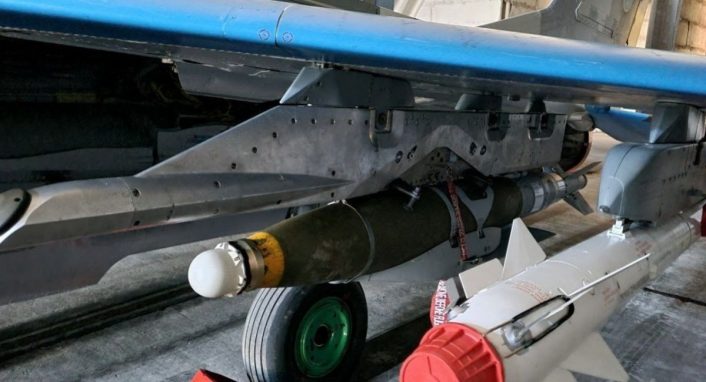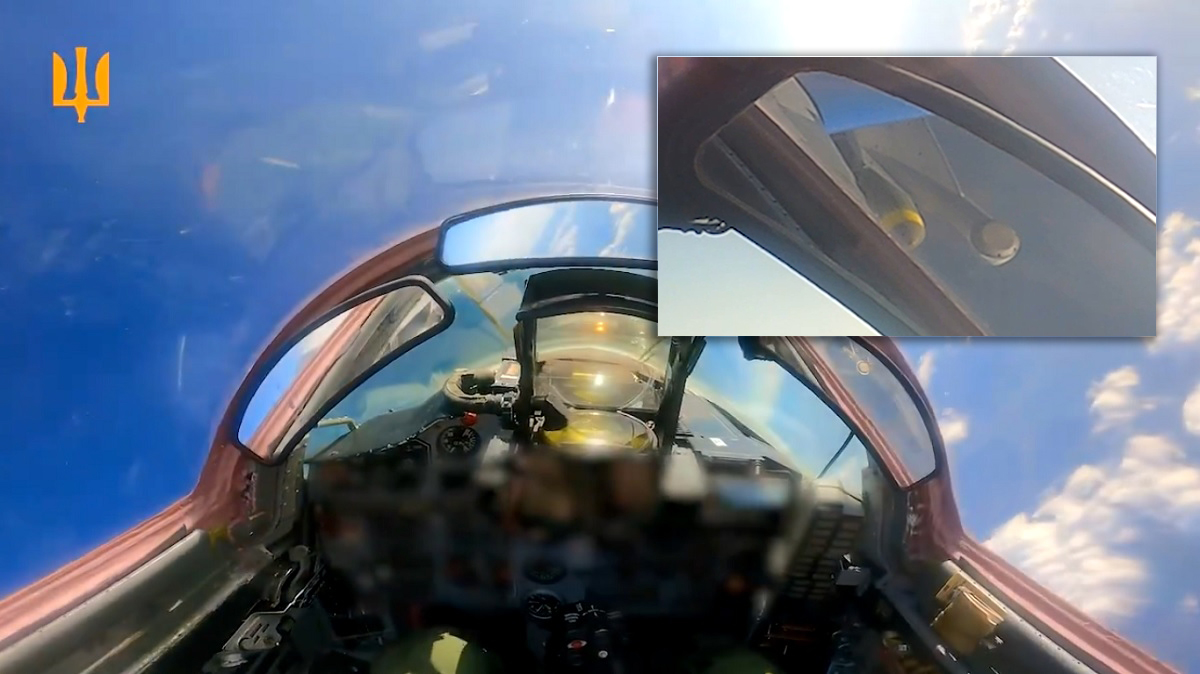The Fulcrums of the 40th Tactical Aviation Brigade are busy performing stand-off attack with Western air-to-ground weapons as well as air defense against UAVs.
A video released by the Ukrainian Air Force commander Mykola Oleschuk few days ago on his Telegram channel shows for the first time the cockpit view of a MiG-29 employing the GBU-62 JDAM-ER. The same video also shows the MiG’s Head-Up Display (HUD) view of a Russian Unmanned Aerial Vehicle (UAV) being shot down with an air-to-air missile, as well as a double AGM-88 HARM attack.
Oleschuk mentioned that the MiG-29s belong to the 40th Tactical Aviation Brigade, which is performing both air defense and air-to-ground attack duties. The ground personnel are doing everything possible to keep the aircraft in operational conditions and protect them from Russian surveillance.
“I am sure that with the arrival of Western aircraft to all tactical aviation brigades of the Air Force, this work will be much more effective,” said Oleschuk. “At the moment, our pilots are squeezing everything possible out of the Soviet-made equipment available in service”.
The MiG-29 fighter jets of the Ukrainian 40th Tactical Aviation Brigade at work.
At the 00:54 it drops a guided JDAM-ER bomb. pic.twitter.com/3HYUvEwN35
— 𝔗𝔥𝔢 𝔇𝔢𝔞𝔡 𝔇𝔦𝔰𝔱𝔯𝔦𝔠𝔱 🇬🇪🇺🇦🇺🇲🇬🇷 (@TheDeadDistrict) June 17, 2024
The GBU-62 JDAM-ER in Ukraine
Ukraine received last year the GBU-62 JDAM-ER (Joint Direct Attack Munition-Extended Range) guided bomb, which are being employed by its fighter jets thanks to special purpose-built pylons. The kit combines a pop-out wing kit with the well-known GPS tail guide kit, improving the stand-off capabilities of the weapon.
Compared to the standard JDAM which can reach up to 15 miles, the Extended Range variant can hit targets 45 miles away, keeping the launching aircraft further away from enemy air defenses. It wasn’t immediately known which variant of the weapon was sent to Ukraine, however photos later showed that bomb body being employed with the JDAM-ER kit is the 500 lb Mk-82.
For the first time, footage has been released showing a Ukrainian Air Force MiG-29 Fulcrum conducting a standoff strike with a US-supplied JDAM-ER glide bomb.
The Ukrainian MiG launches the glide bomb while climbing at high altitude behind the front. pic.twitter.com/ewd0DJkGoQ
— OSINTtechnical (@Osinttechnical) June 17, 2024
In March 2023, US and Ukrainian officials confirmed the delivery and the combat employment of the weapon, respectively, but the weapon was never seen in Ukrainian use until July 2023. Now, a year later, we have the first video of its combat employment as seen from the cockpit of the MiG-29.
The video shows the Fulcrum performing a standoff lofting attack, climbing at high altitude over friendly territory to further increase the range of the JDAM-ER, inverting the route shortly after releasing the weapon. The moment of the bomb release is shown clearly with a close-up view of its reflection in the cockpit mirrors.
What I believe is the first clear image of the front end of the JDAM-ER pylon for Fulcrum.
As I and others suspected, it appears to house a GPS antenna for aligning the weapon’s GPS/INS prior to weapon release.
(h/t @johnjennings101) https://t.co/CnsyJez1E6 pic.twitter.com/0VwFw9tQOk
— John Ridge 🇺🇸 🇺🇦 (@John_A_Ridge) June 17, 2024
The close-up view from the mirrors also allows to get a better view of the pylons used to carry the JDAM-ER. In fact, the GBU-62 has been installed on the inner pylons of the aircraft by using a modified pylon with addition of the standard MAU-12 ejector rack (normally used on the F-15 and F-16), as well as what appears to be a GPS antenna in the front to possibly align the JDAM’s guidance kit before release.
As we recently reported, Ukraine is expected to receive Home-on GPS Jam seekers to be integrated into existing JDAM wing kits. The seekers will help counter the proliferation of Russian electronic warfare systems that caused the effectiveness of GPS-guided weapons to take a plunge.

MiG-29 vs UAV
The war in Ukraine has seen a drastic increase in the use of UAVs, not only in the classic Intelligence, Surveillance and Reconnaissance role, but also for attacks, with the heavy use of “kamikaze drones” and First-Person View attack drones. Many means are being used to counter these unmanned assets, including the MiG-29s and even Yak-52 training aircraft.
The MiG-29s (and the Su-27s too) are routinely seen carrying at least two R-73 Archer IR-guided air-to-air missiles, in addition to air-to-ground weaponry. In some instances they carry heavier loads, including the R-27 Alamo semi-active radar homing air-to-air missile.
The clip shows the MiG-29 at low speed behind the unidentified UAV, launching a missile at it. The footage’s quality doesn’t allow to discern useful details, although that segment appears to be part of a video released last year which was said to depict a MiG-29 shooting down an Orlan 10 drone, one of the main Russian reconnaissance drones, with a R-27 missile.
MiG-29 as HARM carrier
The AGM-88 HARM (High-speed Anti-Radiation Missile) was the first U.S.-made weapon to be integrated on the Soviet fighters since the beginning of the war in Ukraine. The weapon has been widely used there since 2022 to enhance the SEAD (Suppression of Enemy Air Defense) capabilities of the MiG-29 and Su-27.
During a recent interview, Ukrainian Air Force Command’s chief of aviation, Brigadier General Serhiy Golubtsov, said the anti-radiation missile is being used every day, showing its effectiveness. However, Russian air defense crews appear to have learnt to identify the HARM, turning off their radars and letting the missiles pass in order to reduce their losses.
Although it’s not the first time, the video shows two instances of the HARM employment. In the first segment, a double “Magnum” (the radio call used to communicate an AGM-88 launch) is shown, with the launch of two missiles in rapid succession while at low altitude. The second segment shows a single missile being launched at night.













